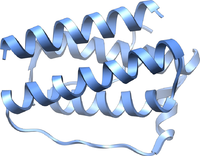
Photo from wikipedia
Obesity favors the development of cardiometabolic alterations such as type 2 diabetes (T2D) and the metabolic syndrome (MS). Obesity and the MS are distinguished by an increase in circulating leptin… Click to show full abstract
Obesity favors the development of cardiometabolic alterations such as type 2 diabetes (T2D) and the metabolic syndrome (MS). Obesity and the MS are distinguished by an increase in circulating leptin concentrations, in parallel to a drop in the levels of adiponectin. Consequently, the Adpn/Lep ratio has been suggested as a maker of dysfunctional adipose tissue. We aimed to investigate in humans (n = 292) the reliability of the Adpn/Lep ratio as a biomarker of adipose tissue dysfunction. We considered that an Adpn/Lep ratio of ≥1.0 can be considered normal, a ratio of ≥0.5 <1.0 suggests moderate-medium increased risk, and a ratio of <0.5 indicates a severe increase in cardiometabolic risk. Using these cut-offs, 5%, 54% and 48% of the lean, normoglycemic and without-MS subjects, respectively, fall within the group with an Adpn/Lep ratio below 0.5; while 89%, 86% and 90% of the obese, with T2D and with MS patients fall within the same group (p < 0.001). A significant negative correlation (r = −0.21, p = 0.005) between the Adpn/Lep ratio and serum amyloid A (SAA) concentrations, a marker of adipose tissue dysfunction, was found. We concluded that the Adpn/Lep ratio is a good indicator of a dysfunctional adipose tissue that may be a useful estimator of obesity- and MS-associated cardiometabolic risk, allowing the identification of a higher number of subjects at risk.
Journal Title: Nutrients
Year Published: 2019
Link to full text (if available)
Share on Social Media: Sign Up to like & get
recommendations!